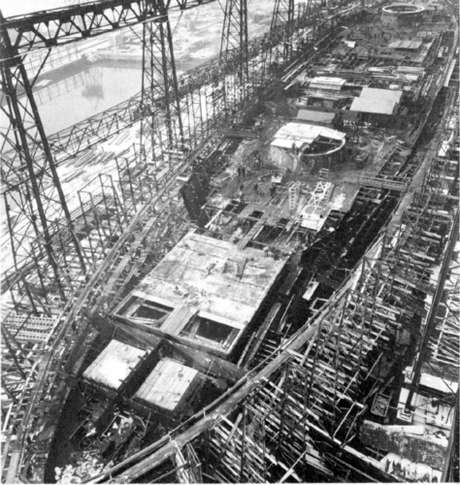Wednesday 19 March 1941
 |
| King George and Queen Elizabeth visit Swansea on 19 March 1941 (WalesOnline). |
East African Campaign: Major-General Lewis Heath, in command of the Indian 5th Infantry Division, is planning a thrust straight up the Dongolaas Gorge that controls access to Keren. The Italians rather unhelpfully have dumped rocks and other debris into the gorge to make travel through it impossible except by hikers. The Italians are sitting at the head of the gorge with clear fields of fire against anyone attempting to advance through it. Heath's plan is to neutralize those Italian positions via diversionary flank attacks which draw their fire elsewhere, giving the Royal Engineers time to clear a path through the gorge. This will require taking positions overlooking the gorge. Heath begins assembling his entire division, which will take some time. Thus, the Battle for Keren once again goes into abeyance for a few days while the British build up their troop strength and logistics.
The Italian attacks on Fort Dologorodoc continue. At 04:00, the 10th Alpini Battalion attacks and gets to within 70 yards of the fort. However, the British defenders beat them back, pursuing them with bayonets and grenades. The British reshuffle their forces, with Indian 3/5 Mahratta occupying the fort and the 2nd West Yorkshire Regiment taking up positions outside the walls.
The British forces at Jijiga begin advancing further. They now are about eight miles beyond the town. Indian troops continue advancing from Berbera and are about 100 miles past it.
 |
| HMS Helvellyn, sunk during the Luftwaffe attacks on London on 19 March 1941. |
On the 19th/20th March : Bombing was concentrated on East London and the London Docks, where there were more major fires than on any date since the 29th December, causing considerable damage.The fires and other damage kill about 750 people. In addition, many ships in the harbor are damaged or sunk, including:
4962-ton British freighter Nailsea Meadow (damaged at Victoria's Dock, two deaths)
- 5780-ton British freighter Telesfora De Larringa (one death)
- 5248-ton British freighter Lindenhall (sunk and refloated)
- Royal Navy auxiliary anti-aircraft ship HMS Helvellyn (sunk).
Visiting Australian Prime Minister Robert Menzies is in the north visiting manufacturing plants. He is in Sheffield and notes:
Sheffield has suffered gravely. 60,000 out of 180,000 houses affected - But Industries going magnificently. Spirits superb. No surrender. No compromise (emphasis and punctuation in original).The factories in Sheffield, Menzies notes, are manufacturing 14" plates and 14" gun barrels.
 |
| Glasgow Herald, 19 March 1941. This headline about U-boats heading toward the US coast is a bit premature - but the Battle of the Atlantic indeed is creeping ever closer to North America. |
The Luftwaffe (KG 40 Focke-Wulf Fw 200 Condors) attacks Convoy OB 298 in the Northwest Approaches and sinks 5193-ton British freighter Benvorlich. There are 5-20 deaths (accounts vary), the rest of the crew is picked up by another convoy freighter, the Zamalek.
The Luftwaffe bombs and sinks 1367-ton Norwegian freighter Leo northwest of the Butt of Lewis. Everyone survives.
The Luftwaffe bombs and damages 8245-ton Dutch tanker Mamura in the mid-Atlantic. Tankers are tough to sink, and Mamura is able to make it to Halifax.
The Luftwaffe bombs and damages 642-ton British freighter Juno at the Surrey Commercial Dock. The Juno is written off.
U-105 (Kapitänleutnant Georg Schewe), on its second patrol out of Lorient, continues his attacks on Convoy SL-68. Just after midnight, at about 00:25, he fires a spread of torpedoes at the ships. Only 7750-ton transport Mandalika is hit and sunk. There are three deaths and 62 survivors, picked up by HMS Marguerite. Some sources claim that U-106 makes this attack.
Convoy SL-68 is experiencing all sorts of strains due to the German attacks, and this kind of unrelenting stress can lead to mistakes and disaster by itself. British 6114-ton freighter Clan MacNab collides with Norwegian freighter Strix and sinks near the Cape Verde Islands.
British 4762-ton freighter Tottenham hits a mine and is damaged at the Southend Anchorage. It is towed to Gravesend.
Norwegian coaster Nyegg runs aground at Egersund, Norway.
German tanker Nordmark meets German raider Kormoran for resupply midway between Africa and Brazil.
Convoy OB 299 departs from Liverpool.
 |
| The Benvorlich, sunk by the Luftwaffe today. |
British Middle East Commander General Archibald Wavell now is receiving Ultra decrypts. He learns from them that Luftwaffe leaves have been canceled and the Germans are planning an offensive.
Another Malta resupply convoy operation, MC 9, departs. Three ships, with escorts, departs from Haifa, and another leaves Alexandria to join the others. The convoy is MW 6/Force C.
Royal Navy submarine HMS Truant attacks an Italian barge at Buerat El-Hsun, Libya, but misses.
The Admiralty makes the difficult decision to pull the remaining Sunderland flying boats from their base at Kalafrana and send them to Alexandria. The Luftwaffe has destroyed or damaged several of them recently, and they are too vulnerable lying at anchorage when the Luftwaffe has a dominance of the skies. Weather is poor today, and there are no bombs dropped on the island though there are some close approaches to the island.
An Italian convoy carrying troops and supplies for the Afrika Korps departs from Naples bound for Tripoli.
Battle of the Pacific: US destroyers USS Aylwin and Farragut collide during night tactical exercises off Hawaii. There is one death aboard the Aylwin.
 |
| Lonsdale Avenue, East Ham bomb damage. 19 March 1941. |
It would be a very great help if some American warships and aircraft could cruise about in this area as they have a perfect right to do.Churchill, of course, would like a great deal more than this, but feels this is both helpful and fairly benign in terms of US neutrality. In addition to this, Churchill wants the US Navy to seize interned Axis ships and use them as Allied shipping, and also to begin convoys of their own. Roosevelt and his team, such as Navy Secretary Frank Knox, are very sympathetic and looking into some other ways to help, too, including having US Navy aviators fly British search aircraft. However, it will take a little time before everyone in the US government has meetings about this and actual steps are taken.
German/Yugoslav Relations: Adolf Hitler is running up against some hard deadlines. Spring is approaching and with it the campaigning season. The Wehrmacht needs to know what role Yugoslavia and its military will play in the events that are about to unfold in the Balkans. Accordingly, Hitler tells the Yugoslav Regent, Prince Paul, that he wants Yugoslavia to sign the Tripartite Pact by the beginning of next week, five days hence.
German/Japanese Relations: Following up on discussions he has had with Hitler, Admiral Raeder floats the idea of attacking Singapore with the Japanese ambassador.
 |
| Jackson Daily News, 19 March 1941. |
German Dissidents: German refugees in London form the Union of German Socialists, a group that opposes Hitler and his form of government.
US Military: The 99th Pursuit Squadron is activated. This formation, based at Chanute Field in Rantoul, Illinois, trains hundreds of enlisted men for ground support duties for formations such as the famous Tuskegee Airmen.
British Government: Churchill's "Battle of the Atlantic" committee has its first meeting.
US Government: "Wild Bill" Donovan has just returned from his extended fact-finding mission in Europe. He meets with President Roosevelt to discuss his findings.
China: At the Battle of Shanggao, the Japanese now are in possession of the first line of Chinese defenses. Both sides call in reinforcements, the Japanese from their bases, the Chinese from the third line of their defenses. Basically, this is the beginning of a short lull in the battle.
British Homefront: Woolton Pies - mass-produced vegetable casseroles - go on sale for 8 pence per pound. They are composed primarily of potatoes, onions and other foods in plentiful supply. Cheese rationing is to begin next week.
March 1941
March 1, 1941: Rettungsboje
March 2, 1941: Oath of Kufra
March 3, 1941: Germans in Bulgaria
March 4, 1941: Lofoten Islands Raid
March 5, 1941: Cooperation With Japan
March 6, 1941: Battle of Atlantic
March 7, 1941: Prien Goes Under
March 8, 1941: Cafe de Paris
March 9, 1941: Italian Spring Offensive
March 10, 1941: Humanitarian Aid
March 11, 1941: Lend Lease Become Law
March 12, 1941: A New Magna Carta
March 13, 1941: Clydeside Wrecked
March 14, 1941: Leeds Blitz
March 15, 1941: Cruisers Strike!
March 16, 1941: Kretschmer Attacks
March 17, 1941: Happy Time Ends
March 18, 1941: Woolton Pie
March 19, 1941: London Hit Hard
March 20, 1941: Romeo and Juliet
March 21, 1941: Plymouth Blitz
March 22, 1941: Grand Coulee Dam
March 23, 1941: Malta Under Siege
March 24, 1941: Afrika Korps Strikes!
March 25, 1941: Yugoslavia Joins The Party
March 26, 1941: Barchini Esplosivi
March 27, 1941: Belgrade Coup
March 28, 1941: Cape Matapan Battle
March 29, 1941: Lindbergh Rants
March 30, 1941: Commissar Order
March 31, 1941: Cookie Bombs
2020








